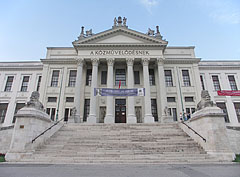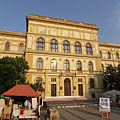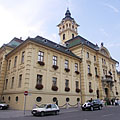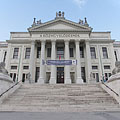
 Туристичке и путничке информације
Туристичке и путничке информације
(Оптимизован за уређаје са малим екранима)

Szeged
The city of science
The city of science
on the River Tisza
on the River Tisza
Szeged, situated on the River Tisza, is the centre of South-Eastern Hungary, where thousands of tourists visit each year. Some of them go there for the cultural events, others to see the inner city decorated with oleanders. There are people who just like to have a nice walk alongside the river or taste the famous fish soup. So there is no shortage of reasons to visit here, and when you are here, you simply will not want to go away.

Szeged lies on the right bank of the Tisza. It was built on the islands which used to emerge from the former flood plain at the confluence of the Tisza and the Maros. The area among the islands was soon drained, so the area of the city became unified. The three islands, Alszeged, Felszeged and the Vár a palánkkal (Castle with a wooden fence) form the heart of Szeged respectively, while Alsóváros and Felsőváros became the inner city.

The settlement was mentioned by Ptolemaios, although at those times he used to call it Partiszkon. The Romans established a watch-tower here, thus they secured the passage through the Tisza and the road leading to Dacia from Pannonia. For centuries it meant a steady development for the city because Szeged was the most suitable place to distribute the salt coming down the Maros from Transylvania. This guaranteed a strategic significance for the city, which provided Szeged with the attention and the privileges of rulers for centuries.
During the Tartar invasion, in the 13th century, the inhabitants of the settlement took shelter in the marshes. When the danger was over they moved back and built up the destroyed city. Béla IV granted Szeged the same privileges as Buda and Székesfehérvár already had. The stone castle was built also at this period. Its strategic significance grew with the approach of the Turks, and King Sigismund encircled the castle with walls.

But unfortunately it could not resist the Turkish army, which marched through the city and plundered it, so the population had to leave and scatter to the surrounding area. The wealthy and educated population moved to other cities, mainly to Debrecen and Kassa, and their place was taken over by the Turks and other Southern Slav people. Szeged, unlike other cities, became a fiscal city, which meant that the ‘haradzs’ or ‘harács’, the land tax was directly given to the sultan.
During the early 18th century several plains (‘puszta’) were attached to Szeged as the result of possessory actions, so its territory increased considerably.

A tragic event in the history of the city occurred on the night of 12 March 1879, when the swollen Tisza broke through an embankment and flooded the city, destroying most of the buildings. Out of 5723 buildings only 265 survived, and seventy thousand people moved to other settlements, altogether only ten thousand people stayed in Szeged.
The city was completely rebuilt, with the help of several European cities like Vienna, Berlin, Brussel, London, Paris and Rome; these cities are recorded in the names of the grand boulevard.
Cathedral Square

The thousand year old history of the architecture of Szeged, famous people and the cream of scientific life are associated with the square. The Gothic Dömötör Tower is situated here, on Romanesque foundations, also the Votive Church, the university and ecclesiastical building complex with hundreds of statues exhibited in the National Memorial Hall.
The Nobel-prize winner Albert Szent Györgyi worked here. The largest rural organization of the Hungarian Academy of Sciences is here and also the buildings of the University of Szeged, which has more than twenty thousand students.

The cathedral
This is probably the most renowned symbol of Szeged and can be found on Cathedral Square.
It takes pride in the fact that it has the largest organ and one of the biggest bells in Hungary. In recent years it has also been possible to go up the tower to have a view of the city.
The City Hall
Another well-known symbol of the city is the City Hall, which attracts everyone’s attention with its colourful roof and slim tower. Its tower was likened to a dainty ballerina by Mihály Babits, one of the greatest figures of Hungarian literature.
Карактеристике, особине
Врста:
Велики/већи град
Положај:
Европа (Континент) > Мађарска (Земља) > Јужна велика равница (Dél-Alföld) (Туристичка област) > Csongrád megye (county) (Жупанија, округ)
ГПС координате: Ширина 46°15'11", Дужина 20°8'44" (N46 15.18 - E20 8.73)
Szeged - Фото галерија (40 фотографије)
Szeged - Панорамске слике (2 фотографије)
Можете такође бити заинтересовани (Повезане странице):
Дестинације у туристичком водичу:
Szeged (40 фотографије + 2 панорамске слике)
Csongrád megye (county) (189 фотографије + 2 панорамске слике)
Јужна велика равница (Dél-Alföld) (817 фотографије + 14 панорамске слике)
Мађарска (27 287 фотографије + 163 панорамске слике)
и додатно:
(у овде: Csongrád megye)
Hódmezővásárhely (149 фотографије)
Ópusztaszer
Свака панорамска слика овде:
Szeged (2 фотографије)
Јужна велика равница (Dél-Alföld) (14 фотографије)
Мађарска (163 фотографије)
Европа (165 фотографије)
Сваки нормални фото овде:
Szeged (40 фотографије)
Csongrád megye (county) (189 фотографије / 3 галерије)
Јужна велика равница (Dél-Alföld) (817 фотографије / 13 галерије)
Мађарска (27 287 фотографије / 462 галерије)
Европа (30 494 фотографије / 523 галерије)
https://www.panadea.com/sr/guidebook/szeged

Додај у Фаворите Додај у Омиљене
Подели са својим пријатељима!
итд
О нама - Одрицање одговорности -
Сва права задржана
- ©2010-2022
Neuronit Creative Studio - Mogyoród / Будимпешта / Мађарска









